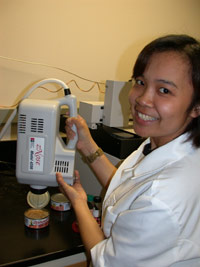 by Doug Schneider June 24, 2004
When it comes to ferreting out spoiled fish, the nose knows. Our olfactory sense has for years been the instrument of choice for consumers and even seafood inspectors. But after a few hours smelling fish, even the best nose can come up a bit short. Our sniffers are, after all, only human. But technology may soon come to the rescue. In the near future the electronic nose-a technological marvel that will never catch a cold, become stuffy or sneeze-may replace the human nose. Alex Oliveira is a researcher at the University of Alaska Fairbanks Fishery Industrial Technology Center in Kodiak, Alaska. Alex Oliveira said, "We are trying to apply a technology that is fairly new. Several industries use a variety of electronic noses for specific purposes, such as control of raw material coming in from processing plants. The electronic nose would be a quick, easy way to indicate is it within limits of acceptance or is it out of the limits of acceptance." Oliveira and colleagues Chuck Crapo and Brian Himelbloom, together with graduate student Jiraporn Chanatarochoti, are this summer testing two types of commercially available electronic noses to see if they might be used to boost seafood quality in Alaska's processing plants. The research is among nine new projects being funded by the Alaska Sea Grant College Program over the next two years, to better understand and use Alaska's marine resources. Perhaps the best-known electronic nose is the Breathalyzer, a device used by police to determine if someone has drunk too much alcohol. Oliveira says the electronic noses she's testing work in a similar fashion; they detect volatiles, or gases, given off by decomposing fish long before the spoilage would be apparent to our merely mortal human nose. Oliveira said, "The first one is called the Cyranose and it's composed of 32 sensors. These sensors interact with the volatiles of the sample. And it results in a pattern of recognition that might aid in quality control, as for product spoilage. The patterns of the volatiles change and with that you can do quality control." While the Cyranose is able to detect the gases associated with spoilage, a second type of electronic nose, called a zNose, is able to also determine the exact cause of the spoilage. Initially, Oliveira says the sensors will be used to measure the amount of ethyl alcohol Oliveira said, "There is some controversy as to why ethanol is present in canned salmon. Ethanol is most likely from bacteria spoilage. But what they don't know is if the bacteria spoilage causes a compound to form that after retorting (cooking) it generates ethanol or if the bacteria generate ethanol as a byproduct of its metabolism." Eventually, Oliveira hopes electronic noses will be used throughout the seafood industry to ensure only the freshest seafood reaches consumers. But there's a lot of work ahead before that can happen. She says research is needed to decide just what constitutes a fresh fish, at least as far as the electronic nose is concerned. And freshness may also differ among species of salmon. For this, she says many fish would have to be tested and standards developed. Oliveira said, "The ultimate goal would be to get a profile by species of salmon. Pink salmon would have specific profiles of spoilage-odors that would show up from fresh, to less than fresh, to spoiled. It might be different for fattier fish like king salmon. You train the electronic nose to do this evaluation and then it becomes a quality control tool." Oliveira says electronic noses should help processors improve the quality of their salmon and other seafood products. Oliveira said, "It improves their ability to discriminate between a bad and a good product in real time. This would be very valuable to processors because a lot of times they are buying fish from a number of boats on the fly as the fish are coming into the plant. And then the other point is to try to avoid sending out product that is unfit." Eventually, Oliveira hopes electronic noses will become small enough and portable enough to be used in supermarkets and restaurants, and maybe even your own home.
Story courtesy Arctic
Science Journeys is a production of the Alaska Sea Grant
Program at the University of Alaska Fairbanks School of Fisheries
and Ocean Sciences.
|
|||
